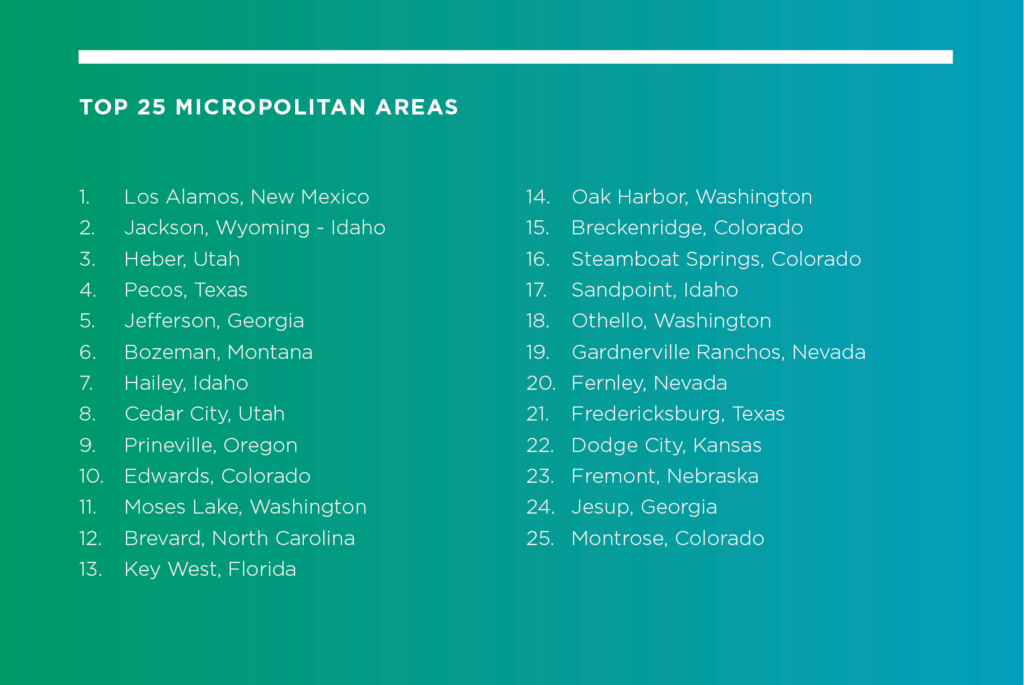COVID-19 created unique challenges and opportunities for America’s micropolitan areas—towns with 10,000 to 50,000 residents and the outlying areas with close economic ties to those communities. In some ways, these challenges and opportunities rewrote the guide to micropolitan economic success, while in other ways they simply reordered the bullet points on that guide. “Most Dynamic Micropolitans: 2022” tells the story of trends that were subverted during the pandemic and those that remained.
We ranked the economic dynamism of 536 micropolitan areas across the United States by studying changes in key economic conditions from 2015 through 2020. We also examined one indicator—the change in employment from September 2020 through September 2021—that reflects communities’ ability to rebound from the early months of the pandemic. (Appendix 1 provides details on the methodology.)
Use the map below to see how each metropolitan area performed:
The Most Dynamic Micropolitan
Our top-ranked micropolitan—Los Alamos, New Mexico—benefited from the expansion of the Los Alamos National Laboratory. While the laboratory has long contributed the area’s economic strength, a $2.5 billion contract with startup Triad National Security, LLC, during the reporting period accounts for this rank. But pandemic-related factors were the primary economic drivers in other micropolitan areas, and these associated patterns are the focus of this report.

Outdoor Recreation
Our third index of micropolitans indicates that natural amenities remain a key characteristic of success. Areas offering a mix of broadband connectivity and access to the outdoors became a respite from the difficulties of pandemic-era city life.
When COVID-19 shuttered the urban amenities that draw many residents to large metropolitans and forced desk-based employees to work from home, the intrigue of an outdoor-centric small town with sufficient internet quality only increased. Communities such as Cedar City, Utah, and Bozeman, Montana, maintained or improved their position near the top of the rankings in 2022. Additionally, Brevard, North Carolina, nestled in the Blue Ridge Mountains of Southern Appalachia, is the 12th-ranked micropolitan, and heartland lake-area communities Spirit Lake, Iowa, and Albertville, Alabama, each vaulted 50-plus positions to place in the top 150.
Food Production and Processing
While those communities built upon a trend that began prior to the pandemic, food-producing communities emerged as a new micropolitan archetype at the top of the rankings.
Micropolitans driven by food production and processing found success, in part, because such operations remained open throughout the pandemic to prevent food shortages. As a result, micropolitans such as Dodge City, Kansas, made significant jumps in our rankings. Dodge City’s largest employer, the National Beef Packing Company, helped stabilize that area’s labor market and propel it 336 spots to No. 22 in our rankings.
Oil and Gas
Oil-producing micropolitans reversed course. For example, Pecos, Texas, relinquished the top spot in our index for the first time, largely because oil drilling, its primary industry, was unprofitable for much of 2020. Still, its pre-pandemic economic growth was so strong that Pecos remains No. 4 in our 2022 rankings. Additionally, its highly productive oil fields were among the nation’s first to reopen, which helped it rebound quickly from its 2020 trough.
Overall, the changes in fortunes for micropolitans dependent on a single industry provide a reminder of the stabilizing benefits of a diversified economy. Liberal, Kansas, for instance, relies heavily on oil extraction, but the presence of ethanol and helium processing, along with food production and processing, helped it navigate the early months of the pandemic better than most micropolitans.
The Heartland
The 335 micropolitans in the heartland region of America delivered mixed results in this year’s national rankings. While 94 of the top 200 are in the heartland, only 30 of those are among the top 100. Agriculture-dependent micropolitans found success during the pandemic, but that trend could dissipate quickly, as it did for oil-reliant micropolitans. More must be done to diversify heartland micropolitan economies if they are to weather the volatility of individual industries.
Download the report